April 6, 2018
Air Date: April 6, 2018
FULL SHOW
SEGMENTS

Pruitt Under Fire
View the page for this story
EPA Administrator Scott Pruitt is caught in a crossfire of criticism from people who question his ethics, extravagant travel, lobbyist-related housing deals and worker salary practices as well as those who see his work to roll back regulations aimed at controlling global warming and other pollution emissions as the wrong direction for America. Key organizations, including the League of Conservation Voters (LCV), have launched a campaign to “Boot Pruitt.” LCV President Gene Karpinski shares with host Steve Curwood his concerns about Administrator Pruitt’s close ties with industry and his efforts to rip up key Obama policies such as the Clean Power Plan and fuel economy standards. (06:48)

Beyond the Headlines
/ Peter DykstraView the page for this story
Peter Dykstra and host Steve Curwood discuss research on some perils of eating out, scrutinize the Maine Governor’s push to weaken pesticide controls and remember the critical role of journalist and activist Marjory Stoneman Douglas in saving the Everglades in Florida. (04:12)

Pruitt Seeks To Double Auto Emissions
View the page for this story
EPA administrator Scott Pruitt has announced that the agency will start the process of scrapping Obama-era auto emissions standards negotiated with the automakers, a move that if completed, would double allowable vehicle pollution in 2025 compared to existing rules. The decision also sets the stage for a possible legal battle with California, which wants to keep its more stringent standards. Host Steve Curwood spoke with Dan Becker of the Safe Climate Campaign. (09:55)
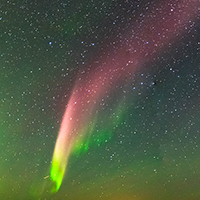
Steve in the Sky
View the page for this story
Liz MacDonald, of NASA’s Goddard Space Flight Center, gives host Steve Curwood an update on the mysterious heavenly purple and green ribbon of light dubbed “Steve.” Thanks to collaboration between citizen scientists and astronomers, this strange phenomenon has been explained – but “The Blob” in the night sky is still a mystery. (09:20)
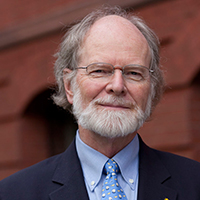
Tyler Prize for McCarthy
View the page for this story
Distinguished Oceanographer and leading climate scientist James J. McCarthy of Harvard is a co-recipient of this year’s Tyler Prize for Environmental Achievement. Host Steve Curwood joins Professor McCarthy on the Harvard campus to talk about the early influences that launched his long career as a biological oceanographer, and his hopes for the future of climate science. (13:53)

BirdNote®: Walk Down an Arroyo
/ Mary McCannView the page for this story
Dry, sandy creek beds, called arroyos, are a refuge for an abundance of birds in the Southwest. In today’s BirdNote®,Mary McCann takes a tuneful stroll through this desert habitat. (02:08)
Show Credits and Funders
Show Transcript
HOST: Steve Curwood
GUESTS: Gene Karpinski, Dan Becker, Liz McDonald, Jim McCarthy
REPORTERS: Peter Dykstra, Mary McCann
[THEME]
CURWOOD: From Public Radio International, this is Living on Earth.
[THEME]
CURWOOD: I’m Steve Curwood. The EPA Inspector General investigates Administrator Scott Pruitt’s questionable travel and hiring practices. And green groups launch a campaign to Boot Pruitt.
KARPINSKI: He's trying to rip up the Clean Power Plan, trying to rip up the clean car standards; at almost every instance, Scott Pruitt is doing the bidding of the big polluters and sacrificing public health. That's why he's got to go.
CURWOOD: Also, NASA explains the celestial phenomenon of Steve – but there are plenty of mysteries still out there…
MACDONALD: The citizen scientists have told us about a type of aurora that they call ‘the Blob’ aurora because it sits overhead for a couple of hours, as opposed to most aurora, which change much more rapidly than that.
CURWOOD: Turning our eyes to the skies and more this week on Living on Earth – Stick Around!
[NEWSBREAK MUSIC: Boards Of Canada “Zoetrope” from “In A Beautiful Place Out In The Country” (Warp Records 2000)]
[THEME]
Pruitt Under Fire
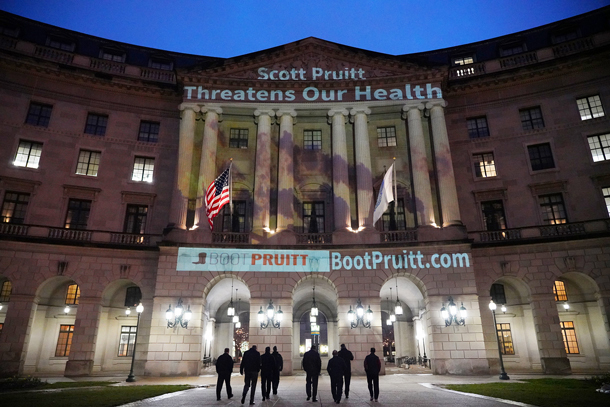
The League of Conservation Voters helped kick off the Boot Pruitt campaign by projecting messages onto the Environmental Protection Agency’s Washington, D.C. headquarters on March 28, 2018. (Photo: Liz Gorman / Bellvisuals.com)
CURWOOD: From PRI, and the Jennifer and Ted Stanley Studios at the University of Massachusetts, Boston, this is Living on Earth. I’m Steve Curwood.
It’s fair to say Scott Pruitt is the most controversial EPA Administrator since Anne Gorsuch Buford was hit with contempt of Congress back during the Superfund scandal in 1983 and forced to resign during the first two years of the Reagan Administration. Like Scott Pruitt she tried to cut 30 percent of the EPA budget, and was seen as too cozy with business interests she was sworn to regulate. But Scott Pruitt has arguably angered even more of the Washington establishment left and right, with what might be seen as personal veniality combined with an all-out assault on many environmental regulations. And most famously he persuaded President Trump to pull out of the Paris climate agreement, isolating America from every other nation on Earth.
Republicans as well as Democrats in Congress have demanded his resignation, along with eco groups that say it’s time to “Boot Pruitt.” Here to discuss is Gene Karpinski, President of the League of Conservation Voters. Gene, welcome back to Living on Earth!
KARPINSKI: Great to be with you, Steve. Thanks.
CURWOOD: I understand that there are both policy and ethical concerns you have with Scott Pruitt. First, what concerns you most about the EPA policy changes he's led in his first year. Maybe you want to start with climate?
KARPINSKI: Well, look, let's be clear. At almost every instance, Scott Pruitt is doing the bidding of the big polluters and sacrificing public health. He's trying to rip up the Clean Power Plan, he's trying to rip up the Clean Water Plan. Just this week he's trying to rip up the clean car standards. Again, the Clean Power Plan and the clean car standards were two of the biggest steps this country has ever taken to cut carbon pollution that causes climate change. He hasn't succeeded yet, but he's sure doing all he can to try to make those no longer the law of the land.
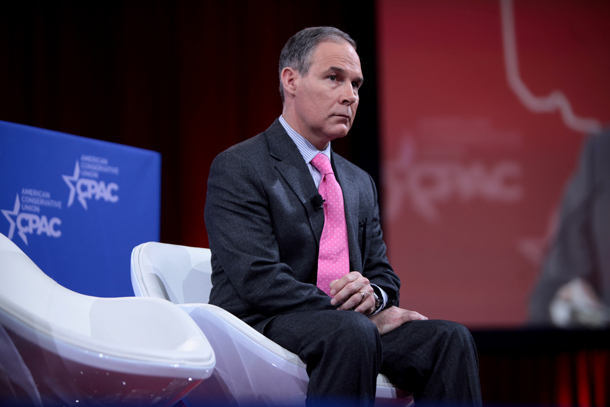
EPA Administrator Scott Pruitt is under public scrutiny for numerous potential ethical breaches, including his below-market-rate rental of a bedroom in a condo owned by the wife of a top energy lobbyist. (Photo: Gage Skidmore, Flickr CC BY-SA 2.0)
CURWOOD: What about his record regarding toxic chemicals, Gene?
KARPINSKI: So, you know, Congress to their credit passed a very bipartisan reform of TOSCA, which is well, well, well overdue, but unfortunately it seems like Mr. Pruitt is ignoring the implementation of law, and even more outrageously, the president asked for a 31 percent cut in the EPA budget and Pruitt went along with that. Now, the good news is that Congress said no way, no how. In fact, they kept the EPA budget stable at least. It should be rising, but at least it kept it stable. But the president and the administrator of the EPA want to cut the budget.
CURWOOD: Now, his previous job was as Attorney General of the state of Oklahoma where at one point, he said it was his job to sue the EPA. What do you make of his record, his selection, and the results of that selection?
KARPINSKI: Well, you're absolutely right. In fact, he brought 13 or 14 lawsuits. The good news is he lost basically every one of those and he was unsuccessful as an attorney general because the previous EPA administrators Lisa Jackson and Gina McCarthy were following the law. And he basically lost in court every time. Unfortunately, though, with the new president, the president wants him do the wishes of the people who helped put him in office, which is big oil, dirty coal companies, and Scott Pruitt was their guy.
CURWOOD: Now, the "Boot Pruitt" campaign is also pointing to you have said are serious ethical red flags with Mr. Pruitt. Tell me about those.
KARPINSKI: Sure, he's clearly ripping off taxpayers as well. So, we saw things about him flying first class for seemingly no real good reason. We saw him getting a sweetheart deal on condo rent in DC. No one else would get that kind of deal. It just so happened that the people renting him also were doing business at the EPA and they had clients before the EPA. That was outrageous. Even just recently in the last couple of days, we saw that he's given special raises to some of his most favorite employees that he brought with him from Oklahoma. Finding loopholes in the way you're able to get raises and giving tens of thousand dollars to people who are some his best buddies in the EPA who are doing the bidding of the polluters.
CURWOOD: You don't like his ethics, you don't like what he's doing. What, if any, laws do you allege that Mr. Pruitt has violated?
KARPINSKI: So, I think...look, clearly in terms of his policy proposals I think we're going to find when we go to court, he's abused the process as he's tried to redo the Clean Power Plan, redo the clean water rule, redo the clean car standards that he's proposing right now. I think he's going to be stopped in court. There were years spent developing the Clean Power Plan, the clean water rule, the clean car standards. You have to have a process, you have public participation and you take the science. You follow the science, and he seems to be just skirting the law and subverting the process just to do the bidding of the polluters.
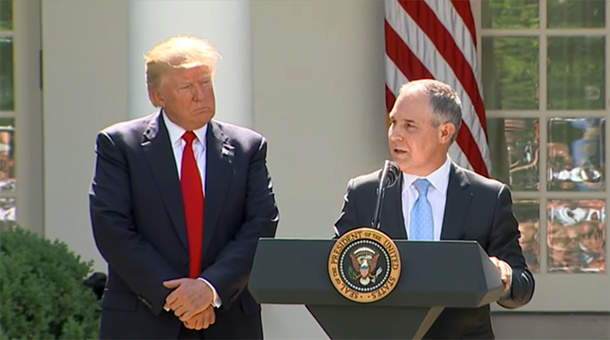
EPA Administrator Scott Pruitt and President Donald Trump on the day they announced the U.S. would pull out of the Paris Agreement, June 1st, 2017. (Photo: screenshot of PBS NewsHour stream)
CURWOOD: Hey, Gene, you and I are both old enough to remember Ann Gorsuch, who came in trying to cut 30 percent of the EPA budget when President Reagan first came to power. What - she hired industry people to regulate areas related to their businesses, and she was forced to resign before her second year on the job was up. I believe she was cited for contempt of Congress over a records request relating to a Superfund scandal. See any parallels here?
KARPINSKI: Well, you know, prior to Pruitt, Ann Gorsuch was definitely the worst EPA administrator. In fact, if you look at the first President Bush administrator Bill O'Reilly, he understood the environmental mission. Look, the second President Bush, Christine Todd Whitman, his first EPA administrator, understood the mission of the EPA. So, Gorsuch was a glaring exception to both Democrats and Republicans appointing people to understand the mission. But Scott Pruitt is just definitely the worst. That's why he's got to.
CURWOOD: You know, your campaign is running an ad on Fox and Friends and Morning Joe, both shows, by the way, that President Trump is known to regularly tune into, and I'd like to play the audio now from that ad.
PRUITT: I’d like to say something. I think he’s an empty vessel when it comes to things like the constitutional rule of law.
NARRATOR: That's Scott Pruitt, Donald Trump's head of the EPA talking about Donald Trump. The same Scott Pruitt under investigation for wasting more than $100,000 taxpayer dollars on first class flights, and who's failed to enforce laws that protect Americans from arsenic and mercury. Scott Pruitt, playing taxpayers and President Trump and dangerous to your family's health.
CURWOOD: So, Gene, let's say that Scott Pruitt does get the boot, as you would say. Who would replace him, do you think?
KARPINSKI: Well, that's… one step at a time here, I'll say. We just launched this campaign. It's incredibly important, so let's see how this plays out. I wouldn't want to speculate but we'd like to think that we could find someone who actually understands and agrees that mission of the EPA, which is to protect public health, keep our air and water clean, rather than someone who spent a lot of his career suing EPA for doing its job.
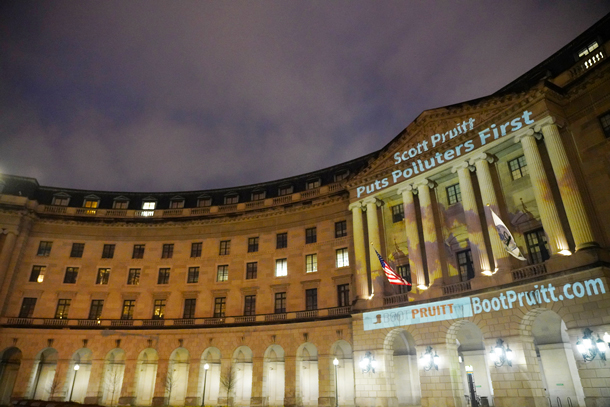
In addition to the League of Conservation Voters, the Boot Pruitt campaign is being led by several other organizations, including the Sierra Club, Defend Our Future, Earthjustice, Hip Hop Caucus, #GreenForAll, GreenLatinos and NRDC. (Photo: Liz Gorman / Bellvisuals.com)
CURWOOD: Gene Karpinski is President of the League of Conservation Voters. Thanks so much for taking the time today.
KARPINSKI: Great to talk to you again. Thanks.
CURWOOD: The press office at the EPA declined repeated requests via telephone and email to comment on this story.
Related links:
- The Boot Pruitt campaign
- ABC News: “Environmental groups launch ads on Fox & Friends to “boot Pruitt”
- The New York Times: “Pruitt Had a $50-a-Day Condo Linked to Lobbyists. Their Client’s Project Got Approved.”
- The Atlantic: “Scott Pruitt Bypassed the White House to Give Big Raises to Favorite Aides”
- The Washington Post: “EPA to roll back car emissions standards, handing automakers a big win”
- The New Republic: “If Scott Pruitt gets fired, he might be replaced by a former coal lobbyist.”
[MUSIC: Bernard Purdie, pedagogical demonstration by Drummerworld, by Bernhard Castiglioni]
Beyond the Headlines

Researchers found that people who ate out in the past 24 hours had higher levels of phthalates, a hormone-disrupting chemical, in their bodies. (Photo: Matiinu Ramadhan, Unsplash)
DYKSTRA: Doing ok and I hope you’re doing well. Let’s talk about phthalates but if anybody wants to Google them, let’s spell them first. It’s P H T H A L A T E S. And phthalates are an endocrine disrupting chemical. A half a billion pounds a year, according to the EPA, are manufactured in the U.S. for things like food packaging and other uses in plastics.
CURWOOD: So, what’s going on with phthalates?
DYKSTRA: Well according to a new study in the Environment International Journal, they studied 10,000 people and found that 30-55% of them had higher levels of phthalates, this endocrine disruptor, in their systems if they had eaten out in the past 24 hours.
CURWOOD: So, what could be the cause?
DYKSTRA: Well possibly the food packaging, the way it’s cooked, industrial cooking equipment. Everything from plastic wrap to other things used in a kitchen.
CURWOOD: So, wait a second Peter, endocrine disruptors in certain cases are linked to obesity, sometimes they’re called obesogens, and you’re raising the specter that quite possibly if you eat, say, junk food that’s wrapped up in plastic that the plastic will also help make you fat.
DYKSTRA: Sure, I’m not raising that specter though, that’s been found in research in the past. And this new research suggests that if you eat at home, you’re going to save more than just money.
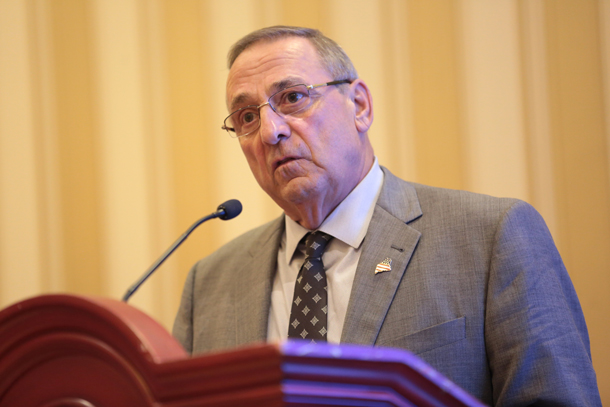
Republican Maine Governor Paul LePage is currently engaged in a controversy surrounding state municipalities’ pesticide restrictions. (Photo: Gage Skidmore, Wikimedia commons, CC BY-SA 2.0)
CURWOOD: Ok, what else do you have for us today?
DYKSTRA: Let’s talk about Maine governor Paul LePage. In his two terms he’s been a strong, outspoken opponent of when the federal government comes in and bigfoots state policy, tries to override what the state wants to do. But now it seems he’s trying again to bigfoot 30 municipalities that have passed restrictions on pesticide use.
CURWOOD: Uh huh, so what exactly does he want them to do?
DYKSTRA: Well this is his third try, either by the governor or by his allies, he wants to have every municipality in Maine stick to the weaker state standard rather than the stronger ones that some communities, including Maine’s biggest city, Portland, have enacted. And also, let’s think back a few years ago to something rather infamous that the governor said in a controversy about another endocrine disrupting chemical, bisphenol A. There were plans for restrictions in the state, the governor opposed those restrictions, and he said quite incorrectly that the worst-case scenario for endocrine disruption from bisphenol A was that we would have, quote, “women with little beards.”
CURWOOD: Oh my. Hey, what do you have from the history vaults for us this week?
DYKSTRA: Well here’s a name that most folks have probably heard a hundred times in the past month or so. Born this week in the year 1890, Marjory Stoneman Douglas, who had that high school in Parkland, Florida named after her for her work, the high school where that horrible massacre occurred a short time ago. She was a reporter till age 57, then she made an abrupt career change at age 57, writing the book “River of Grass” about saving the Everglades.
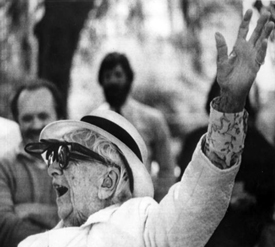
Marjory Stoneman Douglas is now a household name in the wake of the mass shooting at the Parkland, Florida school that bears her name. Ms. Douglas was a tireless reporter and activist who wrote extensively about saving the Everglades. (Photo: State Library and Archives of Florida, Wikimedia commons public domain)
CURWOOD: Yeah in fact it’s really an important reference when you go down to look at what’s happened at the Everglades.
DYKSTRA: Yeah and they’re not saved yet but she’s regarded as the heroine, the main figure in protecting the Everglades. She died in the year 1998 and worked right up until her death, which was at age 108.
CURWOOD: Wow.
DYKSTRA: Here’s a quote that she gave to a radio interviewer when she was 91 years old and still completely active in the cause of saving the Everglades. She said, “This whole thing is an enormous battle between man’s intelligence and his stupidity. And I’m not at all sure that stupidity isn’t going to win out in the long run.”
CURWOOD: Well I guess the jury is still out on that one, Peter.
DYKSTRA: Right.
CURWOOD: Peter Dykstra is with Environmental Health News, that’s ehn.org and dailyclimate.org. We’ll talk to you again real soon.
DYKSTRA: Alright Steve, thanks, we’ll talk to you soon.
CURWOOD: And there’s more on these stories at our website, loe.org.
Related links:
- Environmental Health News: “Would you like phthalates with that burger?”
- Portland Press Herald: “LePage looks to override local pesticide rules in 30 municipalities. But why?”
- NPR: “Who was Marjory Stoneman Douglas?”
[MUSIC: Louis Armstrong, “When the Saints Go Marching In” on When the Saints Go Marchin’ In, Traditional African-American Spiritual, Delta Records]
CURWOOD: Coming up, more on the EPA and an astrophysical phenomenon with a very human name—Steve! That’s just ahead on Living on Earth, keep listening!
ANNOUNCER: Support for Living on Earth comes from the Gordon and Betty Moore Foundation, and from a friend of Sailors for the Sea, working with boaters to restore ocean health.
[CUTAWAY MUSIC: Louis Armstrong and His Dixieland Seven, “Mahogany Hall Stomp,” on Complete 1930-47 – RCA-Victor Studio Sessions, RCA Victor]
Pruitt Seeks To Double Auto Emissions
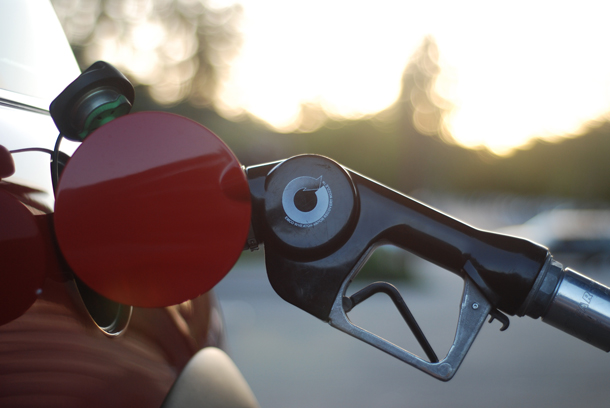
Cheap gas prices may be contributing to the market for SUVS and other large vehicles with poor fuel economy. (Photo: gosheshe, Flickr CC BY 2.0)
CURWOOD: It’s Living on Earth, I’m Steve Curwood. As Gene Karpinski mentioned earlier in this program, EPA administrator Pruitt recently called for the rollback of rules that now require automakers to cut emissions of new cars and light trucks in half by 2025. Here’s what he said at a news conference.
PRUITT: As you know, I'm here to announce that those standards that were set that we are obligated to evaluate, we are determining, I am determining that those standards are inappropriate and should be revised. This will begin a process to determining that those standards are inappropriate and should be revised. [APPLAUSE]
CURWOOD: But twentyfive governors and 50 mayors have criticized Administrator Pruitt’s plans. Among those most concerned are Californians, as Mr. Pruitt is also looking to rescind a federal waiver that allows the Golden State to impose tougher vehicle pollution standards than the federal government. Dan Becker, Director of the Safe Climate Campaign is a vocal opponent of weakening the vehicle rules and he joins us now. Welcome to Living on Earth, Dan!
BECKER: Thanks a lot, Steve. Great to be here.
CURWOOD: So, what effectively has happened here? What has the Trump administration done with this announcement?
BECKER: Well, the Trump administration is giving a huge gift to polluters by rolling back the biggest single step any nation has ever taken to combat global warming and save oil, and it's really a cynical effort to make America polluted again.
CURWOOD: Now, one of the rationales that was offered is that, “Hey, we can do this because the price of oil, price of gasoline is cheap”. What do you think of that?
BECKER: The price of gasoline is certainly cheaper than it was when the rules were established, but there are a lot of other reasons why these rules make sense beyond just saving consumers money at the pump, and even at these lower gas prices these standards will still save the average consumer $6,000 dollars at the pump over the life of the vehicle and that's net of the technology that saves the gas, and if you add it all up across the country it's a trillion dollars in savings over the life of this program. Not only that, in the long term, most people understand that gas prices won't stay low forever.
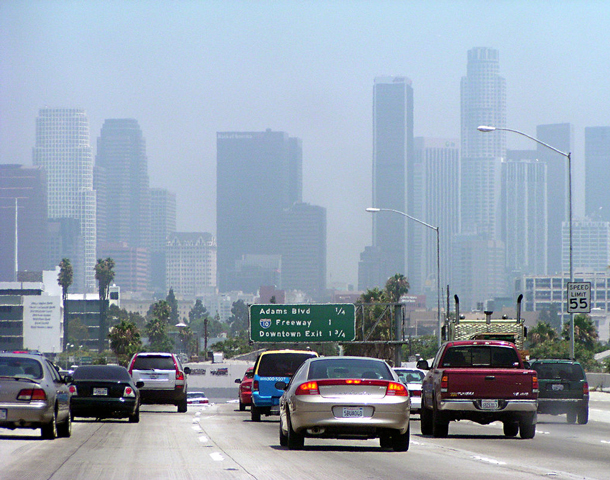
Weakening the fuel efficiency standards could mean urban areas like Los Angeles, California could have as much as double the tailpipe emissions compared to if the Obama standards remain in place. (Photo: Jay Peeples, Flickr CC BY-NC 2.0)
CURWOOD: So, if you say that the Obama era fuel efficiency standards save consumers some trillion dollars, if they don't get to save that money, if the rule gets rolled back, where does that money go? The pocket of the oil companies?
BECKER: Of course, if you're buying gasoline that you don't otherwise need to buy, you're enriching the Exxons of the world and the countries from which Exxon gets its oil, countries that America has conflicts with whether they're in the Middle East, or South America or elsewhere.
CURWOOD: So, I'm scratching my head here trying to figure out why many of the automobile companies that so painstakingly negotiated the original deal with former President Obama have now decided to rally around its demise.
BECKER: Well, they not only negotiated it and they stood with him at a press event to applaud it, they also signed letters of commitment saying that they would not challenge these standards unless certain things happened and those things didn't happen. So, what the auto industry did was they recognized that the Trump administration was a key opportunity to roll back these standards. They never liked them, but they were willing to live with them because, partly in exchange for agreeing to the standards, they got an $85 billion dollar bailout, but they weren't terribly grateful for that as they're showing today in that they want to now produce more gas guzzlers that keep America addicted to oil. So, poor recompense for a bailout, but they couldn't resist the opportunity to get a short-term boost in their profits. For example, GM has an Escalade, the Cadillac Escalade, which is a Cadillac pickup truck. It sells for $71,000. They make $35,000 pure profit on that, according to The Detroit News. And the Ford Motor Company sells the F150 pickup truck, they sell three-quarters of a million every year, so they advertise the hell out of it because they make between $9,000 and $15,000 on each one, pure profit.
CURWOOD: So, Dan, talk to me about the waiver that California has with regards to vehicle emissions. What is it exactly and how would it be affected by this move by the Pruitt EPA?

A Toyota Prius hybrid vehicle. (Photo: Rebecca Bollwitt, Flickr CC BY-NC 2.0)
BECKER: The waiver is very important. It is a result of a provision in the Clean Air Act of 1970 that recognized that California both had worse air pollution than the rest of the country and had already taken preliminary steps to address it, and those steps were stronger than what the federal government was going to take in the Clean Air Act. So, they said California and other states that choose to follow California's rules can have tougher rules than the federal government does as long as they get a waiver from EPA. Now, the Trump administration comes along and says, we want to weaken the federal agreement.
So, the challenge now is whether the states buckle, which I don't think they will do, and agree to roll their standards back to whatever level Trump sets, or whether the Trump administration allows the states to continue to enforce the existing standards as they had agreed. If that happens, then the auto companies have to decide whether to make all clean cars or send the clean cars to the states that require cleaner cars and send the dirty cars to Oklahoma and the other states in between.
CURWOOD: And there's a third alternative, that is the states may say, “Hey we want to stick with the Obama era rules and Trump Administration says “no, no, no, no”. It sounds like that's a ticket to court?
BECKER: The Trump administration could try to revoke the waiver, but there's no provision in the Clean Air Act that allows them to do that, and there's no precedent for ever having tried it before. So, the likelihood that they would win in court is not great.
CURWOOD: So, what do you see happening to the exporting of cars made in the United States?

Automakers are motivated to stick with SUVS over more fuel-efficient vehicles in part because of short-term profit gains. The best-selling Ford F150 Pickup Truck turns a quick, sizable profit for the car company. (Photo: Bruno RS, Flickr CC BY-NC-ND 2.0)
BECKER: Well, the US auto makers obviously dominate the American car market although not nearly as much as they did before the Japanese and other foreign automakers took away market share by making better cars. But the American manufacturers want to make big inroads in China which is growing rapidly. The Chinese generally don't want gas guzzlers although the American automakers are trying to advertise them in ways to make them the sexy new vehicle for the modern Chinese family. But the Chinese government wants to establish a major auto industry that exports to the United States as well as other countries, and last year the Chinese government established a requirement that in 2025, 20 percent of vehicles sold in China must be electric vehicles.
The Chinese recognize, as many of the other Asian and European manufacturers do, that there's an enormous market for cleaner vehicles that guzzle less fuel and they want to fill that need. The American manufacturers would much rather make gas guzzling SUVs and pickups because they make more money on each one, and so the short term is that the Americans may have trouble selling their gas guzzlers in foreign markets. The longer term is that we may go back to 2008 when Americans also don't want to buy the gas guzzling SUVs and pickups and the American manufacturers face a real crisis.
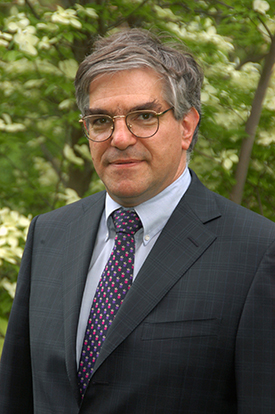
Dan Becker is the founder and director of the Safe Climate Campaign, based in Washington, D.C. (Photo: Dan Becker)
CURWOOD: How important were the Obama era fuel efficiency standards to meeting our commitments in Paris?
BECKER: Very important. The fuel economy and emission standards that Mr. Trump wants to roll back are the biggest single step any nation has ever taken to cut global warming pollution and save oil. They would save 12 billion barrels of oil and six million tons of CO2 over their lifetime so those savings represent the largest chunk of emissions reductions that any country offered up at the Paris Climate Agreement. No other country is going to come close, and if we don't come close either it's pretty likely the Paris Agreement will fail.
CURWOOD: So, Dan, some 50 mayors and 25 states have signed a letter saying that this is really a bad thing, that rolling back these fuel efficiency standards is not helpful and that's more states than who are actually part of the California compact. I think there are 12, 13 states in that.
BECKER: Absolutely, more states and more mayors recognize that air pollution is important and that they don't want more of it, so they've signed on to urge the administration away from these rollbacks. That's very encouraging. It may also hint that more states want to join the dozen or so that follow California's rules.
CURWOOD: So, what's the process here and what are the prospects of reversing this course of action?
BECKER: There's a long process that Mr. Pruitt and Trump have to undertake in order to roll back these standards. They've only just begun that process. It will depend in part on whether their proposals are reasonable or unreasonable in the eyes of a court, and if the court deems them unreasonable they'll be tossed out and the existing rules will continue. If the Trump administration and the automakers go to war with California and the States, it will be messy, it will take a long time it will end up in expensive and extensive litigation and although I think we’ll win at the end and prevail with cleaner vehicles and a cleaner atmosphere, the next administration will have to clean up this mess and will have to decide for not just the cars being made through 2025, which are what are at risk here, but also the vehicles that will be made beyond 2025, and the auto companies know it and Mr. Trump may learn it, in this process the states bat last.
CURWOOD: Dan Becker is the director and founder of the safe climate campaign. Dan, thanks so much for taking the time with us today.
BECKER: Thanks so much, Steve. I really enjoyed it.
Related links:
- More on Dan Becker & The Safe Climate Campaign
- EPA Information on Fuel Economy Standards
- Watch Pruitt’s full press conference about the rollback here
[MUSIC: Woody Guthrie, “Take Me Riding in the Car” on Asch Recordings, Vol. 1: This Land Is Your Land, Smithsonian Folkways]
Steve in the Sky
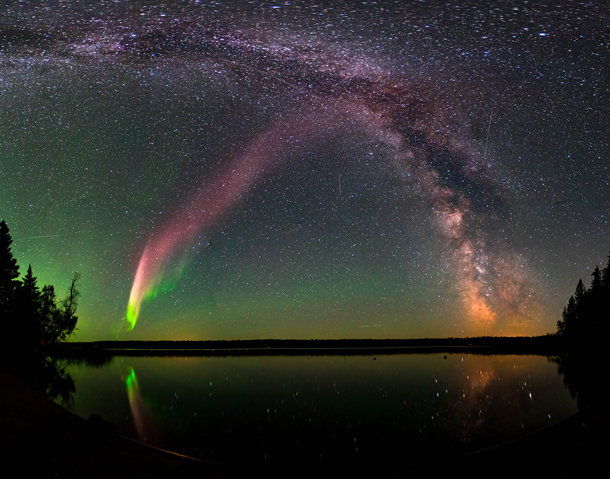
A composite of images captures STEVE (Strong Thermal Emission Velocity Enhancement) over Manitoba, Canada. (Photo: NASA Goddard Space Flight Center, Flickr Public Domain)
CURWOOD: In May 2017, we told you the story of “Steve,” a glowing purple and green ribbon across the sky that mystified sky watchers because it shows up much further south than the famous northern lights called Aurora Borealis. These observers decided to call it “Steve,” echoing the woodland creatures in the children’s movie Over the Hedge.
PENNY: I would be a lot less afraid of him if I just knew what he was called.
HAMMY: Let's call it Steve.
VERNE: Steve?
HAMMY: It's a pretty name.
HEATHER: Steve sounds nice.
PENNY: Yeah. I'm a lot less scared of Steve.
OZZIE: Oh, great and powerful, Steve! What do you want?
VERNE: I don't think it can speak.
DEBBIE [FROM BEYOND THE HEDGE]: I heard that, young man!
EVERYBODY SCREAMS.
CURWOOD: Well, now there’s a bona fide scientific explanation for Steve of the nighttime sky – and NASA space scientist Liz MacDonald joins us now, welcome to Living on Earth, Liz!
MACDONALD: Hi, thanks for having me.
CURWOOD: So, what's changed your understanding of Steve since the initial discovery, and what is Steve?
MACDONALD: [CHUCKLES] So, Steve is a new type of Aurora structure that can be seen in the northern or southern sky further south than the usual Aurora. What we now know from the satellite observations is that this structure is associated with a very strong flow of the charged particles in the upper atmosphere that you can actually see when you're looking at Steve. And that signature from the satellite observations - this very narrow long purple arc - is actually something that we the scientists do know and have studied for a long time. It's something called a Sub-Auroral Ion Drift.
CURWOOD: Now you've come up with an acronym, or I guess it's a bacronym for Steve and what is that?
MACDONALD: Yes, so the bacronym was suggested by another of our colleagues and it's Strong Thermal Emission Velocity Enhancement, and all of those terms correspond to what's seen in the satellite observations, and to Steve actually being the visible signature of this Sub-Auroral Ion Drift.
CURWOOD: So, now wait a second. You can make a bacronym of Sub-Auroral Ion Drift.
MACDONALD: Well, that actually already has its own acronym SAID or said. That's what we often call it for short.
CURWOOD: But, I get it now. So, if you see this phenomenon you’re saying this is what STEVE SAID.
MACDONALD: [LAUGHS] Yeah, right. Exactly.
CURWOOD: And of course, what we're looking at when we see this is the visualization of all these charged particles that are usually not visual, but why in this case is it visual?
MACDONALD: Yes, so in this case -- and this is where Steve also gets really interesting -- because in the normal Aurora the light is produced by the charged particles from further out in space raining down on the upper atmosphere and exciting the molecules in the upper atmosphere as they come down the magnetic field lines. And in this case, we think that the light associated with Steve is produced by this very strong flow in the upper atmosphere. So, actually the charged particles are kind of being dragged across the neutral particles in the atmosphere and heating them up. It's kind of more like a frictional heating mechanism and that is producing some light and that that light is in different wavelengths than what you normally see in the Aurora.
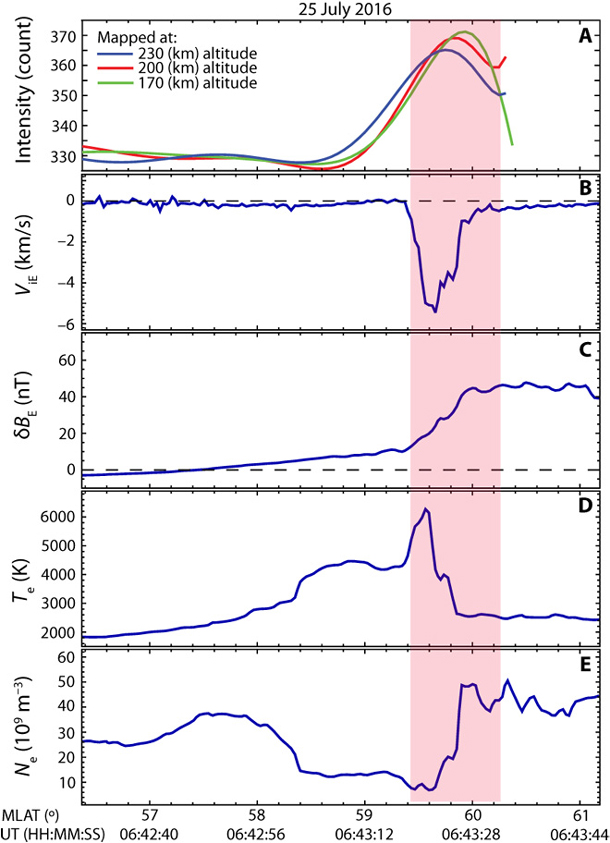
Satellite data shows the STEVE optical emission (highlighted in pink) corresponds with a high intensity of SAID (Box A). This satellite data, combined with citizen science observations, helped scientists make a connection between STEVE and sub-auroral ion drift. (Image: Fig. 3, “The conjunction of the STEVE optical emission with a pronounced SAID signature at satellite altitudes,” MacDonald et al. 2018)
CURWOOD: So, how was your team able to determine Steve's identity?
MACDONALD: Yeah, so we combined the traditional observations from the satellites and also from the University of Calgary's ground-based array of cameras that study the Aurora both in white light and in different specific wavelengths, and then we had really great citizen science observations for this event.
CURWOOD: So, where do you get the ‘strong thermal’ part of the Steve?
MACDONALD: Yes, so the satellite also observes thermal electrons, which are part of the ambient upper atmosphere, and those were extraordinarily heated right in this region where you see the light, and so they were about five times hotter than they usually are and the temperature that we see there is actually around 6,000 degrees which is actually also near the temperature of the surface of the sun. So, something pretty hot.
CURWOOD: So, you're saying that, gee, these particles might be 6,000 degrees? I mean those are very high temperatures. How dangerous is it that it's that hot?
MACDONALD: Well, it's actually not a dangerous thing. It's gases that have gotten so hot that they have split apart, and so they do have a really hot temperature, but they're not very dense, so they're not dangerous.
CURWOOD: So, just a little wisp of a thing, huh?
MACDONALD: Yeah, yeah.
CURWOOD: Now you are the founder of Aurorasaurus which collects observations from amateur photographers worldwide. What was the role of this organization, of this platform in - in identifying Steve?
MACDONALD: Yes so Aurorasaurus in many ways kind of served as the bridge between, you know, the traditional science community and this very vibrant, very enthusiastic and skilled community of Aurora chasers worldwide.
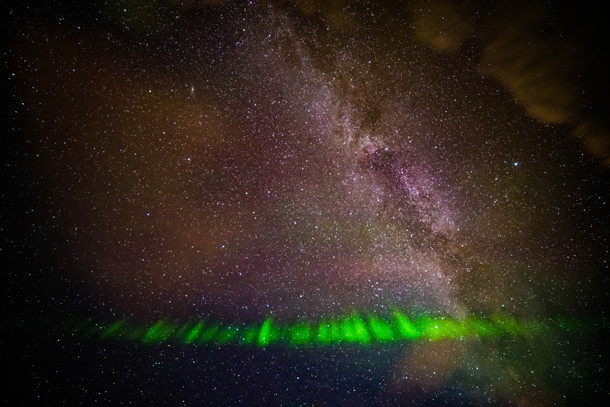
STEVE is sometimes accompanied by green bands of light. (Photo: NASA Goddard Space Flight Center, Flickr, Public Domain CC0 1.0)
CURWOOD: So, to what extent do you think naming this phenomenon “Steve” helped to get people interested?
MACDONALD: It's been really helpful in encouraging people to appreciate the science and appreciate the citizen science as well. We have a lot of jargon in our field, so Sub-Auroral Ion Drift is a mouthful of jargon there. This paper and this discovery kind of shows that we don't need the jargon and that you know it's possible to have a fun name but also have a scientific name, and that people can really contribute to helping us understand the world.
CURWOOD: So, tell me about the significance of understanding Steve and, for that matter, the other phenomena around Aurora.
MACDONALD: Yeah, so that's part of what we call space weather, and so space weather includes all of the many effects of the space environment on our technological assets that rely on space, things like GPS, operating satellites, satellite television, communications, all kinds of communications through the atmosphere, and also power grids on the ground can definitely be affected by the changes that Aurora or Steve can make to the atmosphere, and so it is important to understand all of the parts of - of the system.
CURWOOD: Yeah, of course those of us in the radio business are familiar with this. Back in the day where people would use certain and ionized layers of the atmosphere to bounce signals around the world to today when you know a serious storm can wipe out radio communications or make them quite difficult.
MACDONALD: Absolutely, and there's a citizen science project about ham radio as well called HamSci, and they studied last summer's eclipse and continue to take observations during auroral storms as well.
CURWOOD: So, Liz, before you go, I got another question, but I know this could take all day to answer, so maybe be selective. The question is -- talk to me about other unexplained celestial phenomena we should be aware of.
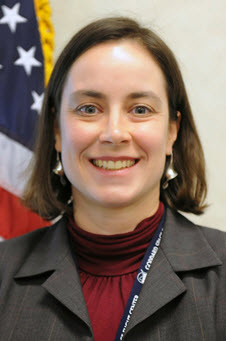
Elizabeth MacDonald is a NASA space scientist, lead author on the STEVE study, and founder of Aurorasaurus. (Photo: courtesy of Elizabeth MacDonald)
MACDONALD: Ooooh, that's a good question. Well, the citizen scientists and the group that we've worked with the most, the Alberta Aurora chasers have told us about a type of Aurora that they call “the blob Aurora” because it sits overhead for a couple of hours as opposed to most aurora which changes much more rapidly than that.
CURWOOD: “The blob”. Sounds a little ominous.
MACDONALD: It does sound cool.
CURWOOD: “The Blob”! Is it safe to be around the blob?
MACDONALD: Yeah, the blob is probably just a particular kind of wave particle interaction. Some of the particles rotate with the Earth, and what that means is that it sits in the same spot because we're on the rotating Earth. And most of the time when you talk to scientists in my field about this, they would say, “No, no that's not going to be visible because it's quite a weak sort of mechanism and hasn't been spotted before”. But one thing that is so exciting about this is that our cameras are getting better every day, and so we're able to see the Aurora more easily.
CURWOOD: Liz MacDonald is a space weather scientist for NASA's Goddard Space Flight Center and lead author of the Steve study, and where's that published, Liz?
MACDONALD: It's published in "Science Advances" and it's open access for everyone.
CURWOOD: So, go look it up if you are interested. Liz, thanks so much for taking the time with us today.
MACDONALD: Thank you so much, Steve. It's always nice to talk to a Steve about Steve.
Related links:
- Science Advances: “New science in plain sight: Citizen scientists lead to the discovery of optical structure in the upper atmosphere”
- Aurorasaurus
- Our original report from May 12, 2017: “The Charm and Mystery of Steve”
- NASA: “The Aurora Named STEVE”
- The New York Times: “Steve, a Famous Northern Light, Stays Mysterious (and Keeps His Name”
[MUSIC: Glenn Miller and His Orchestra, “Moonlight Serenade” on The Unforgettable Glenn Miller, composed by Mitchell Parish/Glenn Miller, RCA Records]
CURWOOD: Coming up, a reward for an outstanding oceanographer. That’s just ahead here on Living on Earth, stay tuned.
ANNOUNCER: Funding for Living on Earth comes from you our listeners, and United Technologies - combining passion for science with engineering to create solutions designed for sustainability in aerospace, building industries and food refrigeration. UTC companies such as Otis, Carrier, Pratt & Whitney and UTC Aerospace Systems are helping to move the world forward. You can learn more about United Technologies by tuning in to the Race to 9 Billion podcast, hosted by UTC’s Chief Sustainability Officer. Listen at raceto9billion.com. That’s raceto9billion.com. This is PRI, Public Radio International.
[CUTAWAY MUSIC: Hans Jürgen Steffenhagen, “Moonlight Serenade” composed by Mitchell Parish/Glenn Miller, not commercially available.]
Tyler Prize for McCarthy
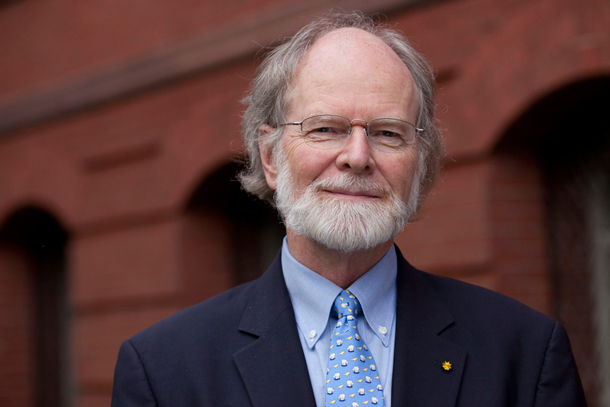
Harvard Professor and oceanographer James J. McCarthy is a co-recipient of the 2018 Tyler Prize for Environmental Achievement. (Photo: C. Cambon)
CURWOOD: It’s Living on Earth, I’m Steve Curwood. Jane Goodall, Jared Diamond, and C Everett Koop are all highly respected science and environmental champions and all are winners of the prestigious Tyler Prize for Environmental Achievement. This year the prize winners are Paul Falkowski and James McCarthy, both distinguished oceanographers who focus on climate change. Harvard Professor James McCarthy co-chaired a working group for the UN’s Intergovernmental Panel on Climate Change and has served as president of the American Association for the Advancement of Science and I met up with him on the Harvard campus in Cambridge – Jim, congratulations!
MCCARTHY: Thank you, Steve. I'm really pleased to be a recipient of this prize. It came as a great surprise to me, and as I look back over the list of recipients over the past four decades, I realized that many of them had been my heroes and my mentors, so it's really quite an honor to be joining their company.
CURWOOD: Professor McCarthy, how did you become interested in science, and ocean science especially?
-Antarctic-Meteorologica-tower.jpg)
James J. McCarthy (far right) at the Antarctic Meteorological Tower. (Photo: courtesy James J. McCarthy)
MCCARTHY: Probably like any kid growing up in a small town, a rural area, interested in the outdoors. It seemed to be what we did as kids. We played outside, we hiked, we fished, we looked for bugs, looked for birds, and I do recall a very formative moment for me when I was probably about 10, and my father gave me a microscope and he took me out to a pond on the edge of town and we filled a test tube with pond water and he tied a string on it and showed me how to spin it over my head and basically centerfuge the particles down into the pellet at the bottom and decanted liquid and we suspended that small pellet microscope and watching these small organisms. And I mean I knew there were fish in those ponds and I knew there were bugs, but I had no idea what was living there in the microscopic realm. And just being really fascinated by what I could see with that microscope. And then as I began to think about an area of science where I could pursue a career and find interesting life I definitely was inclined toward something that would have me involved in field work rather than totally lab based. The ocean was the one I chose, and it wasn't a crazy passion for the ocean, it was really the opportunity to do a science that would work.
CURWOOD: Now, famously, back in 2000, the year 2000, the New York Times ran a picture of you in a ship in the North Pole with open water. Tell me that story.
MCCARTHY: Well, the story is one that we never could have imagined would be on the front page of The New York Times. We were on a Harvard Museum of Natural History tour. We joined this Russian icebreaker expedition. It went from Murmansk through Franz Josef Land to the pole and back. We were expecting to see the - the ice conditions that some of us had seen before. I had been in that area, and when we got beyond Franz Josef land, we just didn't seem to encounter the thick ice that is so common in that area. And we were a little surprised, and as we got closer and closer to the pole, never did we see the multi-year ice - two, three, four meters thick - and so the ice breaker was basically chipping away at amazingly thin seemed like mostly one-year ice and we got to the north pole and all the navigation instrumentation said we were at 90 North and we looked around every direction and you could see ice but we were actually in water.
And as it happened, Malcolm McKenna, who is a paleontologist from the American Museum of Natural History on the trip was one of the lecturers was chatting with someone at a cocktail party and a few days later it ended up on the front page the New York Times. And of course at that time that seemed like an extremely unusual observation, and the reaction to it was also very interesting. There were people who said, “Absolute nonsense.” We had somehow fabricated this whole thing. But as it turns out nobody could have imagined at that point that ice was thinning at the rate it was. People said, “That's impossible, there should be two or three meters of ice there”, and of course we know today, that ice isn't there.
CURWOOD: In some respects, that was something of a wakeup call.
MCCARTHY: It was. Not only did we get lambasted by a number of the very prominent deniers of climate change at that time, some of whom are still active, but they wrote up op-eds and criticized us, but I also had handwritten letters and typed letters from people who had spent years in the Arctic. I remember one fellow who had been a pilot in the Air Force and had flown mobile missions, he said “I just don't think it's possible that you saw what you saw,” and I kept up a correspondence with some of these people. I said, "Well, have you considered that things could have changed?" And look at what we do know about change in this area. So, for a lot of people it was just jarring.
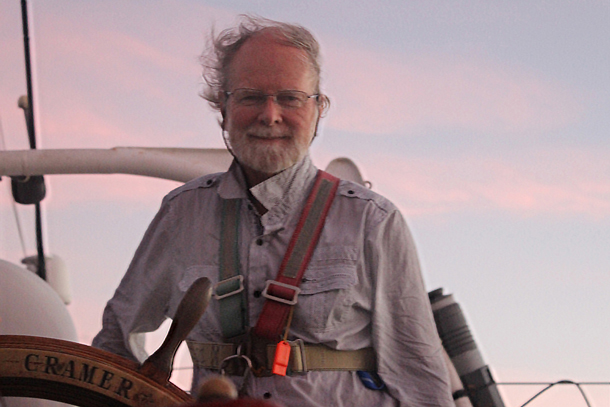
Jim McCarthy at the helm of the Corwith Cramer on a research expedition. (Photo: A. Harley)
CURWOOD: So, you've been at this for a long time. What kinds of pushback have you had when it comes to the question of climate disruption?
MCCARTHY: The pushback has been sort of largely just the stable of regulars who seem prepared to try and diminish every bit of new understanding that comes in climate science as being irrelevant or exaggerated, but we're used to that, and fortunately a lot of them are older than me so they won't be as much a bother to future generations as they were to my generation.
CURWOOD: Let's talk about what's been going on over the past year since the Trump administration has taken over. In the United States there has been quite a shift in government policies, towards science in general and the environment specifically. What if anything concerns you there?
MCCARTHY: I'm extremely concerned about the loss of momentum on the extraordinary international agreement that was struck with the Paris Accord. The good news is that we've seen many cities and states not only express their resolve to continue working in this area, but even up their game. And we've known all along that's an important place where the action has to occur. I'm worried though that the international resolve could be diminished without the US in a position of leadership because what was extraordinary about the Paris Accord was that for the first time you had the United States and China and India all at the table, and all agreeing to not only participate, but to really take leadership roles. The targets that were agreed to, individually determined contributions for each nation that were an extremely important part of getting this agreement, and everyone who looked carefully at those realized that by themselves they will never get us to where we need to be. But they were a start, and to have every nation agreed to come back in five years and assess publicly how well we had, we as each individual nations have done, was an extremely important part of the agreement and to be prepared to ratchet to a higher level of commitment.
We're losing some momentum now without the US pushing hard in this area. We know that President Trump's decision to withdraw cannot become effective until actually, ironically it's right after the next presidential election, 2020. So, he can express his intent, but it can't be finalized. Maybe he will change his mind or if someone else is elected, there could be a different future. What I think is not easily communicated to the public is that if you lose a day working on this problem now, it's not like you can work an extra day later and catch up. The carbon dioxide we’re putting in the atmosphere now, a portion of that will be in the atmosphere hundreds and thousands of years from now. So, everything you can do to slow it today makes tomorrow easier.
CURWOOD: You've been at this, Professor McCarthy, for some 40 years now and when you got started climate change wasn't really a common concern, much less how the world's oceans are involved with - with climate change. So talk to me a bit more about how the field has changed over the course of your career.
MCCARTHY: The field of ocean science has advanced at a pace that at times has been really profoundly disruptive. The one in my experience that’s been the most disruptive has been the advent of satellite observing capabilities. It wasn't until the late 70s, say about 1980, that the first satellites were launched that could demonstrate the capability of measuring ocean properties from space. So, a lot of ocean science today doesn't really require the same effort at sea as it did in the past. That's a good thing. It means it's a lot easier to do a lot of ocean science now, but it also means that perhaps there's not as many people on the ocean observing what's happening there and I can honestly say that every time I've gone to sea, I have seen things that I could not have imagined.
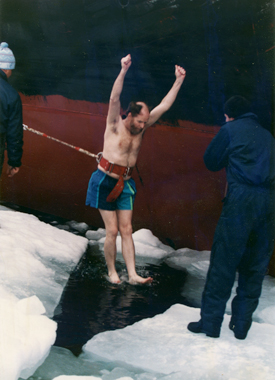
Jim McCarthy takes the plunge in the Arctic Ocean on a research trip to the North Pole in 1994. (Photo: courtesy of James J. McCarthy)
CURWOOD: For example?
MCCARTHY: So, we were out in the Equatorial Pacific in the mid-90s and getting ready to do a routine station. We were doing a section across the equatorial region. We were stopping at one of the stations a few degrees north of the equator, and as we were setting up to do our work there, the man who had been on watch the bridge the night before, one of the crew of the ship said, "I saw the strangest thing on radar last evening." I said, "Well, tell me more." And he said, "Well, it kind of looked like there was something in that water, it was almost like a wall of water, something strange happening with the currents, and the other thing we turned the lights on it looked really, really green." So, I said, where was that? We looked at the chart and realized it was taking the ship back to the direction it had been not that far, a couple hours, and we thought, well, let's do our station there rather than here.
So, we turned the ship around went back, and lo and behold, there was this streak of plankton, a very dense band. It was greenish brownish of photosynthetic plankton that as far as we could see. It turns out that there was a NASA plane sitting in Hawaii that was capable of making measurements of ocean color from space, and one of the people on our team Jim Yoder made a contact and based upon that information they deployed the plane and flew down and documented that this thing went for hundreds of kilometers. Well, it turned out that this was also a moment when the space shuttle was up, and so someone at NASA said, “Hey, next time you're over the Pacific, look out the window and see what you can see”. And they took a picture of this thing, and it ran a couple of thousand kilometers. So, here is this streak of plankton production. It was clearly a current boundary, but this was really stunning. So, it's still very exciting to go to sea. Every time I look forward to being surprised.
CURWOOD: We've been looking at some pretty dire topics looking back on your career, the whole question of climate disruption. Frankly, there's the prospect of upending our entire civilization if we don't get this right. Professor McCarthy, what gives you hope?
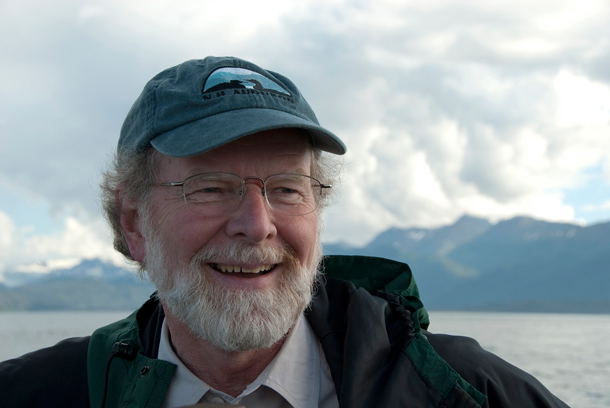
James J. McCarthy. (Photo: P. Raven)
MCCARTHY: The trends are the right direction actually. Today, if you look at the economics in the energy realm and realize that the non-fossil fuel based energy sources are soaring, who could have imagined just a decade ago that today in Iowa you would have 35 percent of the electricity coming from wind, or Oklahoma it's over 20 percent, or that Texas would be building wind and solar faster than any other state. And if you go back not too far in US national policy, we had in the early 2000s, a plan to build another 200 coal-fired power plants. Well, basically, not only did we not build those, but we're closing down a lot of power plants well before the end of their lifetime, coal-fired power plants. Now, part of that is because of the abundance of natural gas which is cleaner than coal, but today, you're finding that wind and in some locations solar is more economically beneficial for a long term investment than even gas fired power plants or electricity.
But what more than anything else gives me hope is seeing the young people today, the college age population who are learning about this subject and wherever they go, whether they go into business and into the public sector, any position in any career they're carrying with them an understanding that they early generation didn't have, the importance of this problem. And when I interact with these students, you see a passion to be involved in the solution side of this question, and I think that's a very very hopeful indication that as we move through this bottleneck, we will emerge much stronger on the other side.
CURWOOD: James J. McCarthy is a Professor of Biological Oceanography at Harvard University and the co-recipient of this year's Tyler Prize for Environmental Achievement. Congratulations.
MCCARTHY: Thank you, Steve.
Related links:
- The New York Times 2000 article on Open Ocean at the North Pole
- About the Tyler Prize and James J. McCarthy
[MUSIC: BIRDNOTE® THEME]
BirdNote®: Walk Down an Arroyo

A Pyrrhuloxia, feathered in grey with red highlights, sits atop a cactus. (Photo: Billy Liar, CC)
CURWOOD: Let’s head to the dry sunny southwest of the US now. As Mary McCann explains in today’s BirdNote, a warm morning there brings out an abundance of eager songsters.
[Greater Roadrunner song]
MCCANN: Have you ever heard a Roadrunner sing? That’s the maker of this cooing sound.
[Greater Roadrunner song]
MCCANN: Want to hear more sounds of the desert Southwest?
[Someone walking along a sandy path]
MCCANN: Come along, as we walk along an arroyo, a dry, sandy creek bed. Arroyo means “stream” in Spanish. With mesquite, yucca, and cactus along their edges, arroyos in the Southwest fill with water only a few times a year, mostly during the heavy rains of late summer. Despite the arroyo’s lack of water at the moment, there’s a remarkable diversity of wildlife here.
[Northern Beardless Tyrannulet song]
MCCANN: That’s a Northern Beardless Tyrannulet singing, a tiny flycatcher with a very distinctive voice.
[Northern Beardless Tyrannulet song]

The Greater Roadrunner is just one of many fascinating birds found in the deserts of the Southwestern United States. (Photo: SearchNet Media, CC)
MCCANN: And there’s a Pyrrhuloxia singing from atop a yucca.
[Pyrrhuloxia song]
MCCANN: The Pyrrhuloxia looks a lot like a cardinal, except it’s feathered in silvery gray, with magenta highlights.
[Pyrrhuloxia song]
MCCANN: Birds here are most active in the morning, except those that are nighttime specialists.
[Call of Lesser Nighthawk]
MCCANN: Just after sunset, we’d hear the drawn-out trill of a Lesser Nighthawk.
[Lesser Nighthawk]
MCCANN: And a cousin of the nighthawk, a Buff-collared Nightjar, might begin to call.
[Buff-collared Nightjar calls].
The sounds of life in an arroyo are magical, day and night. I’m Mary McCann.
###
[Written by Bob Sundstrom Sounds of the birds provided by The Macaulay Library of Natural Sounds at the Cornell Lab of Ornithology, Ithaca, New York. Greater Roadrunner song recorded by A.A. Allen; song of Northern Beardless Tyrannulet 40558 and song of Pyrrhuloxia 40568 by G.A. Keller; call of Lesser Nighthawk 118627 by G.A. Keller; Buff-collared Nightjar 40510 by G.A. Keller. Producer: John Kessler
Executive Producer: Chris Peterson © 2018 Tune In to Nature.org April 2018 Narrator: Mary McCann]
[MUSIC: R. Carlos Nakai, “Song for the Morning Star” on Canyon Trilogy, Canyon Records]
CURWOOD: Saunter on over to our website, loe dot org, for photos and more.
Related links:
- This story on the BirdNote® website
- Read more about the Pyrrhuloxia at All About Birds
- Read more about the Greater Roadrunner at All About Birds
- Read more about the Northern Beardless-Tyrannulet in the Audubon Field Guide
- Read more about the Lesser Nighthawk in the Audubon Field Guide
- Read more about the Buff-Collared Nightjar at Cornell Lab of Ornithology
[MUSIC: R. Carlos Nakai featuring William Eaton, “Feather River Lullaby” on Carry the Gift, Canyon Records]
CURWOOD: Our crew includes Naomi Arenberg, Bobby Bascomb, Savannah Christiansen, Jenni Doering, Jaime Kaiser, Hannah Loss, Don Lyman, Helen Palmer, Aynsley O’Neill, Adelaide Chen, and Jolanda Omari.
Tom Tiger engineered our show, with help from John Jessoe and Jake Rego. Alison Lirish Dean composed our themes. You can hear us anytime at L-O-E dot org - and like us, please, on our Facebook page - PRI’s Living on Earth. And we tweet from @livingonearth. I’m Steve Curwood. Thanks for listening!
ANNOUNCER1: Funding for Living on Earth comes from you, our listeners, and from the University of Massachusetts, Boston, in association with its School for the Environment, developing the next generation of environmental leaders. And from the Grantham Foundation for the protection of the environment, supporting strategic communications and collaboration in solving the world’s most pressing environmental problems. Support also comes from the Energy Foundation, serving the public interest by helping to build a strong, clean, energy economy, from Carl and Judy Ferenbach of Boston, Massachusetts and from SolarCity, America’s solar power provider. SolarCity is dedicated to revolutionizing the way energy is delivered by giving customers a renewable alternative to fossil fuels. Information at 888-997-1703. That’s 888-997-1703.
ANNOUNCER2: This is PRI, Public Radio International.
Living on Earth wants to hear from you!
Living on Earth
62 Calef Highway, Suite 212
Lee, NH 03861
Telephone: 617-287-4121
E-mail: comments@loe.org
Newsletter [Click here]
Donate to Living on Earth!
Living on Earth is an independent media program and relies entirely on contributions from listeners and institutions supporting public service. Please donate now to preserve an independent environmental voice.
NewsletterLiving on Earth offers a weekly delivery of the show's rundown to your mailbox. Sign up for our newsletter today!
 Sailors For The Sea: Be the change you want to sea.
Sailors For The Sea: Be the change you want to sea.
 The Grantham Foundation for the Protection of the Environment: Committed to protecting and improving the health of the global environment.
The Grantham Foundation for the Protection of the Environment: Committed to protecting and improving the health of the global environment.
 Contribute to Living on Earth and receive, as our gift to you, an archival print of one of Mark Seth Lender's extraordinary wildlife photographs. Follow the link to see Mark's current collection of photographs.
Contribute to Living on Earth and receive, as our gift to you, an archival print of one of Mark Seth Lender's extraordinary wildlife photographs. Follow the link to see Mark's current collection of photographs.
 Buy a signed copy of Mark Seth Lender's book Smeagull the Seagull & support Living on Earth
Buy a signed copy of Mark Seth Lender's book Smeagull the Seagull & support Living on Earth

